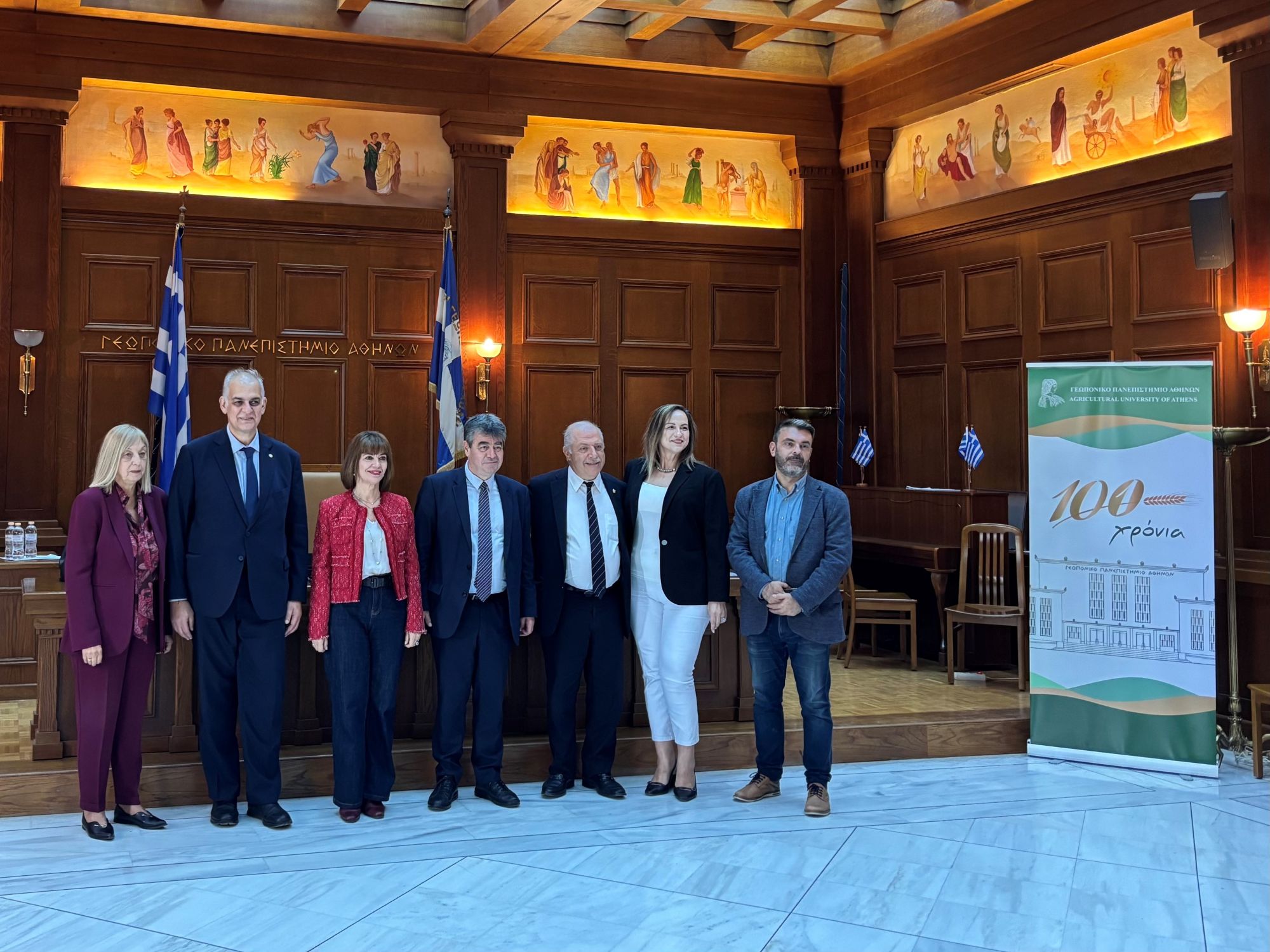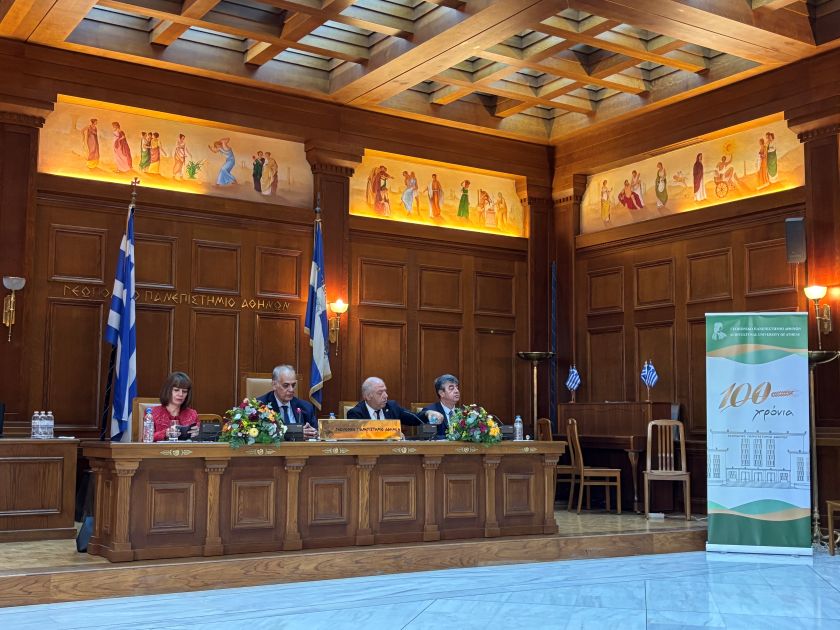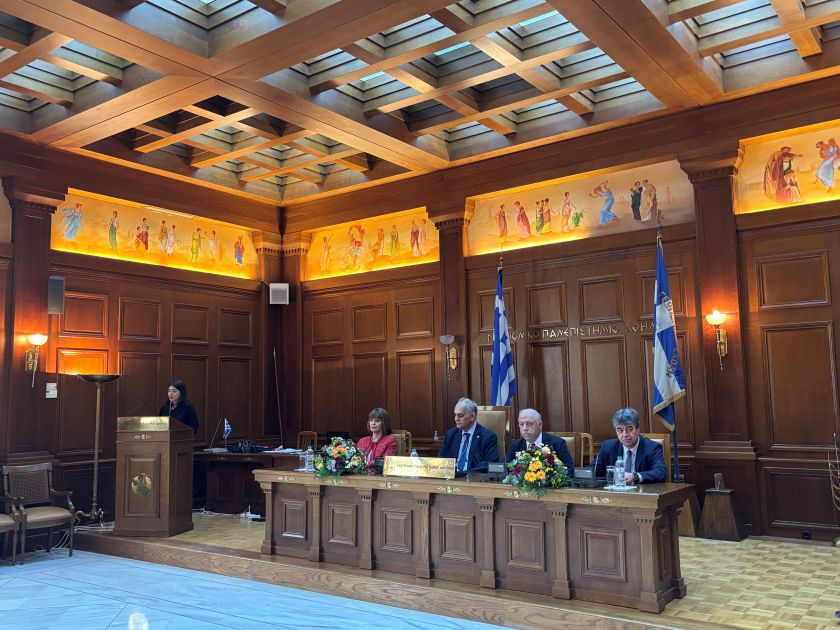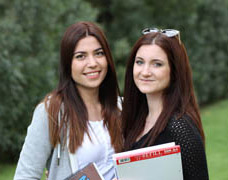The Agricultural University of Athens as coordinator of the “Rhombus” Technology Transfer Cooperation Network

The Agricultural University of Athens as coordinator of the Technology Transfer Cooperation Network “Rhombus”, with partners Panteion University, the University of Piraeus, and the University of Thessaly.
On Friday, 24 October 2025, in the Ceremony Hall of the Agricultural University of Athens, the new “Rhombus” Network was presented— a Technology Transfer Cooperation Network between four Universities, coordinated by the Agricultural University of Athens and partnered by Panteion University, the University of Piraeus, and the University of Thessaly.
The project has a four-year duration and aims to accelerate the transformation of academic research into innovative solutions with measurable social and economic impact, through intellectual property protection, industry contracts, and the creation of spin-off companies. At the core of “Rhombus” lies the synergy of four different academic ecosystems that serve distinct yet complementary fields, as the Rectors agreed.
Specifically, the collaboration aims to develop an interdisciplinary network covering a wide range of research areas—from agriculture, agri-food, and engineering to the social, economic, and human sciences. Its long-term goal is to enhance cooperation between academic institutions by combining these fields and jointly leveraging their research results.
Additionally, the partnership aims to strengthen university–industry collaboration, promote extroversion, foster new collaborations domestically and internationally, and enable the practical utilization of research produced within universities. As noted, the commercial exploitation of research results will introduce new trends in both production processes and services/products, cultivating an entrepreneurial culture in academia and maximizing the impact of universities on society and the market.
Each Institution develops its own organized technology transfer services for its research community—from identifying and legally protecting results to licensing and commercialization. At the same time, common horizontal actions unify procedures, share expertise, and jointly showcase the “product” of academic research to the market. In this way, university–industry interaction becomes systematic rather than incidental: research teams gain access to networking and funding tools, while companies can more quickly identify mature technologies for collaboration or investment.
The joint actions of the partnership cover a broad range of initiatives that will bring universities closer to the business community, strengthen healthy competition and innovation, and support the technology transfer activities of the institutions. Specifically, the partnership has established the following joint actions:
- Commercial exploitation of the Network’s research results
- Promotion and identity creation (branding)
- Information, training, and upskilling of Network staff
Equally crucial is the investment in the human capital of the Technology Transfer Offices. Starting with a needs assessment, an annual training program is being designed for staff, focusing on key areas such as intellectual property law, licensing agreements, technology valuation, partner identification, and funding tools. Continuous skills development ensures a consistent level of service across the four institutions, allowing researchers to receive timely, specialized, and comparable support regardless of institution.
During the Press Conference, the policy framework and project objectives, the organizational structure and the roles of each institution, as well as the timelines for each work package for the first year were presented in detail. Initial actions already underway include:
• the development and pilot operation of the AI-matchmaking platform,
• the design of the common identity and the central website, and
• the scheduling of training seminars for Technology Transfer Office staff.
At the same time, the outward-facing character of “Rhombus” was emphasized, focusing on international collaborations and targeted presentations to sectoral bodies, chambers, and clusters, so that Greek academic research gains visibility where decisions on collaborations and investments are made.
“Rhombus” aspires to change the prevailing culture—from fragmented, individual attempts at technology transfer to a collective, systematic architecture that reduces maturation time, increases licensing success, facilitates contracts with industry, and multiplies the creation of viable spin-offs. As noted, by the end of the four-year period, success will not be judged solely by the number of patents or agreements, but also by the quality of collaborations, the resilience of spin-off companies, the upskilling of Technology Transfer Office staff, and, above all, the impact of academic knowledge on real societal and economic needs.
“Technology transfer is the way we bring research results generated within universities to the market, aiming to create real impact on the economy and society,” stated Katerina Papadouli, Head of the Technology Transfer Office of the Agricultural University of Athens, in her introductory speech. She also emphasized that the new project “constitutes an ambitious partnership among major and important academic institutions in the country, which have contributed—and continue to contribute tirelessly—to equipping the new generation of students and researchers with knowledge, skills, and competencies for their academic and industrial careers.” Over the next four years, the funding provided by the Ministry of Finance and the NSRF Competitiveness Program will allow them “to support, both financially and through excellent human resources, the submission of intellectual property protection files and the creation of contracts for development projects and commercialization with companies and organizations in Greece and abroad, leading to the creation of spin-offs—companies with innovative characteristics,” she concluded.
The Rector of the Agricultural University of Athens and project coordinator, Professor Spyridon Kintzios, focused on the establishment of a new strategy for knowledge utilization to strengthen innovation, both in terms of the university’s scientific philosophy and its cooperation with other universities. He stressed that “Rhombus” will serve as a model for the wider academic community and its human resources.
“Technology transfer, as you know, has in recent years become one of the most critical factors in the development of research, which our universities serve exceptionally well,” he noted, describing as “envy-worthy the performance of Greek universities, even when compared with countries of higher economic status and better funding organization.” “We are here to jointly support and design the mechanism of technology transfer, which transforms academic research into practical benefit and returns to society and the economy the added value of public funding in higher education,” he said.
Professor Kintzios also announced the name “Rhombus” for the Cooperation Network, emphasizing that “the Agricultural University, with its historic trajectory, promotes the use of digital technologies—further enhanced by developments in artificial intelligence—and has consistently demonstrated high performance in this field over the last decade.” He added that since 2001, innovative projects have been implemented with visible results and the development of successful spin-offs (a total of 11). “The diversity of each university’s subject areas allows us to address the challenges of transferring innovation to society, thus creating a knowledge ecosystem,” he said. “The Network aims to become a model of cooperation for the Greek academic community, enhancing the impact of all involved. Through joint education and research-promotion activities, we ensure that new knowledge no longer remains in laboratories but reaches society.”
The Rector of Panteion University, Professor Christina Koulouri, emphasized that “Panteion University has run an innovation structure that was extremely successful in previous years. We have established the Office as part of our new organizational framework, which was recently published—the second such framework adopted among Greek universities—and the Technology Transfer Office is included within it, to be staffed with appropriate personnel. We have also prepared studies in a variety of fields which, as I mentioned, sometimes surprise people—such as psychology, social economy, and of course visual intelligence, which is taught and included in many of the University’s programs.” She added: “We are here to demonstrate that research is not introverted, nor confined to subjects related exclusively to technology and the natural sciences. The presence of the social sciences can truly contribute to the way technology is utilized at the level of society and the market.”
The Rector of the University of Piraeus, Professor Michail Sfakianakis, referring to the Network, emphasized that “we named it Rhombus because the rhombus symbolizes symmetry in the sense of complementarity, which was very aptly explained by our host. Thus, symmetry as complementarity is expressed through this symbol, and that is why we selected this name. The aspect concerning extroversion and synergies is expressed in the best possible way through this initiative, strengthening the link between production, research, and industry, and fostering technological capabilities and the role of our universities as pillars of innovation and development. This project symbolizes cooperation through complementarity, as each university will be able to use the tools of the others, with the main goal of extroversion and the creation of new synergies. The University of Piraeus has founded a computing systems spin-off and is developing nine more spin-offs to promote innovation.”
The Rector of the University of Thessaly, Professor Charalambos Billinis, emphasized that “the entire endeavor will be successful and will mark the beginning of a long-term collaboration among the Universities.” Referring to the University of Thessaly—which spans five cities, eight schools, and 35 departments—he focused on extroversion and the creation of the technology transfer unit Oneplanet Thessaly. Describing its operation, the Vice-Rector for Innovation, Internationalization, Collaboration, and e-Governance, Professor Chrysi Laspidou, noted that innovation seminars are organized across Thessaly through this unit and act as a “magnet,” while highlighting the opportunities that open up for everyone through these collaborations.
More information about the Technology Transfer Offices of the “Rhombus” Network is available here:
InnovinAgri: https://innovinagri.aua.gr/
Creative Plus: https://creativeplus.panteion.gr/
University of Piraeus Research Center: https://www.kep.unipi.gr/
One Planet Thessaly: https://oneplanet.uth.gr/en/




